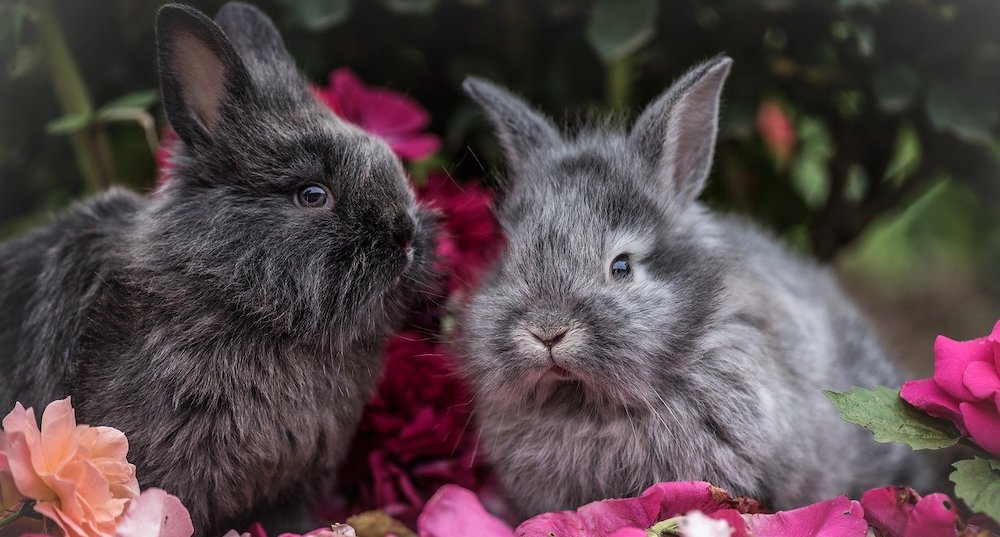
Rabbits are social animals that truly benefit from being bonded in pairs. It is important to them as they are naturally prey animals in the wild; there, they rely on each other for the creation and maintenance of underground burrows, where they spend a lot of their time hiding or socialising. Having a pair also means that they can alert each other to predators, giving them a higher chance of survival. The trait of being bonded carries over to domesticated rabbits; it is important for their wellbeing.
It is highly important to keep bonded rabbits together at all times. If one requires hospitalisation, bring the other one in to stay with them as their buddy. If they need to be separated for whatever reason, we have methods in place to try to maintain their bond, such as scent swapping and maintaining visual contact.
The ideal pair
- One neutered female and one neutered male.
- Same sex pairings are possible, but there may be problems in the springtime, regardless of whether they have been neutered, due to males wanting territory and females wanting nesting materials.
- Similar age and size.
- Both vaccinated and wormed.
If you are purchasing two rabbits from a litter, you should ideally pick the first one and then watch them to see which rabbit they are bonded with already, they should then be your second selection, rather than trying to force a bond. In the same way that we do not get on with every person we meet, rabbits will not get on with every bun they meet – and when it is an instinctual survival mechanism to bond with another rabbit, who is in your ‘pair’ becomes even more important.
If a bonded rabbit passes away, you should bond the rabbit left behind with another rabbit. The best way of doing this is through a rescue centre as they will have a safe area where the rabbit can create new bonds with rabbits that match your home life criteria. Many owners go and buy a new baby bunny (called a ‘kit’) to bond with their elderly rabbit. This often leads to an unhappy pairing, and the owners may end up with 4 rabbits rather than 2, trying to find the right pair for their older and younger bunny.
Sometimes happily bonded rabbits appear to fall out and the bond breaks down. There is almost always a reason for this:
- Maturation and the onset of spring, males fighting over territory and females fighting over nesting material.
- Underlying illness/pain.
- Change in the group e.g. loss of another animal.
- Changes in neighbour’s house and garden – if the neighbour gets a rabbit, yours may be able to smell them.
- Changes in routine, for example the main care-giver changes.
Below is a list of indicators that the bond is beginning to break down:
- Chasing each other
- Being more isolated than normal
- Signs of fur in enclosure
- One of the rabbits hiding more
If you see these happening, return to split mixing (described below) and seek advice from your vet practice – you’ll need to rule out any medical cause for the change.
Introducing rabbits
Before you introduce two rabbits, you need to check that both are healthy, have received anti-parasite treatment, been vaccinated and fully recovered from any illness or surgery (including neutering). Generally, the rabbits will be anxious but excited at the same time, much like humans when they first meet. It is common to see them running, jumping, binkying and possibly courtship or mounting activities.
Before you begin bonding 2 rabbits, ensure you have researched rabbit body language with indications of being relaxed, stressed or aggresive.
Split mixing
Split mixing is the safest way of bonding two rabbits. You can use split mixing for first introductions, when a bonded pair is of mating age but awaiting neutering or if a rabbit is returning from veterinary hospitalisation. The rabbits can see and smell each other but there is a physical barrier between the two of them. The barrier needs to be thick enough that they are not able to harm each other or bite each other’s noses through it.
The rabbits need to have a large amount of space each – minimum of 2×2 metres, with a litter tray and hiding spots. The litter trays should be positioned along the barrier line. Pet remedy plug ins should be used in the bonding room if inside.
Scent swapping daily is highly important to encourage bonding, the below list is ideas of what can be swapped
- Litter trays
- Some bedding from each rabbit moved to the others enclosure
- Wipe a clean, dry cloth over each rabbit and place it in the others enclosure or rub one of them with it then the other
- Swap the rabbits around so that they alternate between each enclosure
If signs of aggression or stress do not resolve within a few days/weeks, it is unlikely that they will bond. You need to wait for relaxed behaviour before you move on to the next stage of bonding – neutral territory.
Neutral territory
Using neutral territory for bonding should only be done if there has been successful split mixing or successful introduction at a rescue centre. Using neutral territory has more risks involved and you should intervene against any unacceptable behaviour straight away. This environment is only temporary, until bonding has occurred. The Rabbit Welfare Association and Fund (RWAF) recommends that the neutral territory is somewhere neither bunny has been before and that it is new to both of them (so not one of their runs).
The space should ideally be at least 2 x 2 metres in a quiet room, free from loud children, banging doors or TVs. There should be plenty of hiding spaces which should have 2 entrances or exits (like a cardboard box with holes cut in or a tunnel) so that the rabbit does not feel trapped and acts aggressively due to fear. Using carriers or hutches as a hiding spot is not appropriate. If possible, avoid bonding on a slippery floor – place an old rug if need be. If the rabbits feel scared and run away or they fight, they may slip and cause painful injuries.
There should be at least 2 sources of water and 2 sources of low value food. High value food, such as treats or fresh fruit/veg can be a trigger for a fight.
The area should be easily accessible by the owners, with a towel handy, so that they can intervene if needed. Rabbit bites can be painful, so best to wear appropriate clothing e.g. toes covered, trousers and long sleeved tops. Even if no aggressive behaviour is seen, check the rabbits over daily for signs of wounds.
Introductions – these will depend on the reaction your bunnies have to one another, as they need to be separated at any sign of one of them being distressed, or tensions rising between them. They need to be supervised during their interactions, so you can catch this early. If you do see signs, separate them and try again the next day, or later in the day depending how early you started. You can then slowly increase the time they spend with each other, stopping interactions that are turning sour. Although a bit of play chasing or nipping is to be expected and are normal rabbit interactions, you don’t want this to be the source of difficulty between them as it can go from playing to a fight quite quickly if one of them interprets the interaction differently.
If they begin to bond (see the relaxed behaviours listed below) then they can be left unsupervised. You may prefer to check in on them regularly at first just to make sure they are still getting on well. Any signs that things are taking a turn should lead to them being separated, and going to one of the earlier steps that they are comfortable with e.g. spending shorter durations together or split mixing.
Deciding on leaving them overnight – If they have exhibited aggression, they need to return to split mixing stages and not be left overnight unattended. If they have shown acceptable behaviour, it should be okay to leave them overnight.
This process can take a very short period of time (a few hours or days) or it can take weeks or months. In some cases, they will never bond – you will be able to tell as the unacceptable behaviours will still be present with little to no improvement even over an extended period of using split mixing/neutral territory.
We would recommend asking a rescue centre to help your bun bond with another rabbit, as an unsuccessful bonding will likely result in having to rehome one of them, or having to find each of them a bonded mate – this is a lot of additional space you need to have available, as well as time and finances to provide them all with the level of care they need. If the second iteration of bonding is unsuccessful, you may be sitting with 4 unbonded rabbits, making the issue exponential.
Aggressive/unacceptable behaviour
- Charging with ears flat and tail raised
- Biting
- Kicking, particularly in the sensitive stomach
- Growling
Stressed behaviour
- Rapid breathing – look for quick nose twitches
- Not eating
- Thumping back feet – they feel as thought they are in a dangerous situation and are scared
Acceptable behaviour
- Minor chasing and nipping
- Some fur pulling which subsides quickly – one or two mouthfuls
- Mounting, providing hiding spaces such as tunnels stop this from happening. Be careful if a male is mounting back to front (with hind legs over the other rabbits head) as he may be bitten somewhere painful – this can cause extensive bleeding.
Relaxed behaviour
- Grooming themselves or each other
- One rabbits head lowered, nudging it under the other rabbit’s chin is a request to be groomed
- Eating
- Ignoring each other
Rabbit bonding can be a difficult process and one you should only attempt if you feel confident – your bun should always have a mate, so if you’re not sure you can manage, then seek advice from your local rabbit rescues who are likely able to (and keen to!) help your bunny find their buddy.
Call us on 01435 864422 if you have any concerns about your rabbit’s health.

